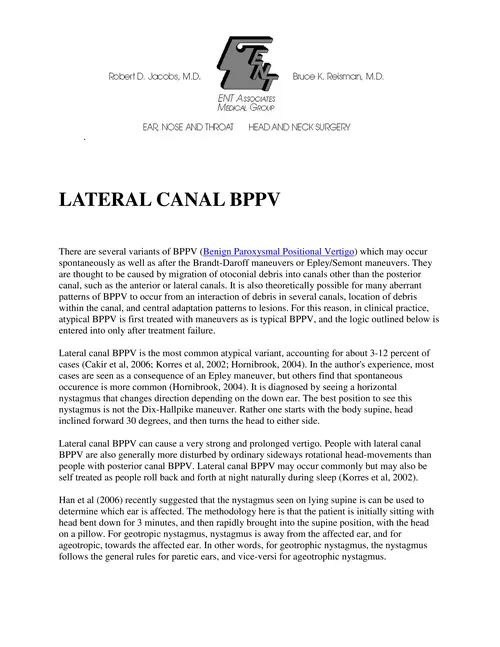
LATERAL CANAL BPPV - Oceanside
with posterior canal BPPV with a particle repositioning maneuver suggestive but not clear, it may be beneficial to use video-.
adsPart of the document
.
LATERAL CANAL BPPV
There are several variants of BPPV (Benign Paroxysmal Positional Vertigo) which may occur spontaneously as well as after the Brandt-Daroff maneuvers or Epley/Semont maneuvers. They
are thought to be caused by migration of otoconial debris into canals other than the posterior
canal, such as the anterior or lateral canals. It is also theoretically possible for many aberrant
patterns of BPPV to occur from an interaction of debris in several canals, location of debris
within the canal, and central adaptation patterns to lesions. For this reason, in clinical practice,
atypical BPPV is first treated with maneuvers as is typical BPPV, and the logic outlined below is
entered into only after treatment failure. Lateral canal BPPV is the most common atypical variant, accounting for about 3-12 percent of
cases (Cakir et al, 2006; Korres et al, 2002; Hornibrook, 2004). In the author's experience, most
cases are seen as a consequence of an Epley maneuver, but others find that spontaneous
occurence is more common (Hornibrook, 2004). It is diagnosed by seeing a horizontal
nystagmus that changes direction depending on the down ear. The best position to see this
nystagmus is not the Dix-Hallpike maneuver. Rather one starts with the body supine, head
inclined forward 30 degrees, and then turns the head to either side.
Lateral canal BPPV can cause a very strong and prolonged vertigo. People with lateral canal
BPPV are also generally more disturbed by ordinary sideways rotational head-movements than
people with posterior canal BPPV. Lateral canal BPPV may occur commonly but may also be
self treated as people roll back and forth at night naturally during sleep (Korres et al, 2002).
Han et al (2006) recently suggested that the nystagmus seen on lying supine is can be used to
determine which ear is affected. The methodology here is that the patient is initially sitting with
head bent down for 3 minutes, and then rapidly bro
ught into the supine position, with the head
on a pillow. For geotropic nystagmus, nystagmus is away from the affected ear, and for
ageotropic, towards the affected ear. In other words, for geotrophic nystagmus, the nystagmus
follows the general rules for
paretic ears, and vice
-versi for ageotrophic nystagmus.


